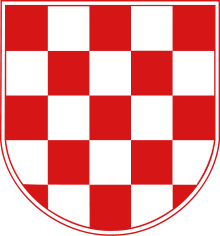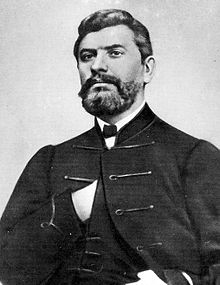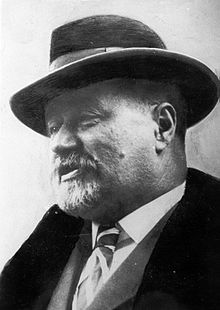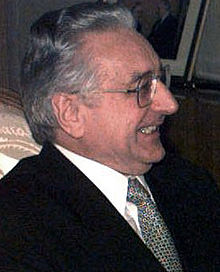- Croatian nationalism
-
 The Croatian "šahovnica". "Šahovnica" means "chessboard" in Croatian, but the term can also mean "chequy". This has been a popular symbol of Croatian nationalism.
The Croatian "šahovnica". "Šahovnica" means "chessboard" in Croatian, but the term can also mean "chequy". This has been a popular symbol of Croatian nationalism.
Croatian nationalism (Croatian: Hrvatski nacionalizam) is the nationalism of Croats or of Croatian culture.[1] It arose in the 19th century in response to Magyarization of Croat territories under Hungarian rule, especially under the influence of Ante Starčević and Eugen Kvaternik,.[1] It became internationally important during World War II and during the breakup of Yugoslavia and the Yugoslav Wars.[1]
Contents
History
In the 19th century, opposition by Croats to Maygarization and desire for independence from Austria-Hungary led to the rise of Croatian nationalism.[1] The Illyrian movement, originally associated with Croatian cultural nationalism but later with Pan-Slavism, founded the Matica Hrvatska (Croat Literary-Cultural Foundation) in 1842 that promoted the Croatian language and demanded that Croatian ("Illyrian") be adopted as the Croatia's official language.[2] Illyrianists during the Revolutions of 1848 sought to achieve political autonomy of Croatia within a federalized Habsburg monarchy.[3] Ante Starčević founded the Party of Rights in Croatia in 1861 that argued that legally, Croatia's right of statehood had never been abrogated by the Hapsburg monarchy and thus Croatia was legally entitled to be an independent state.[3] Starčević regarded Croatia to include not only present-day Croatia but also Bosnia and Herzegovina , Slovenia, Serbia —all people in this Greater Croatia whether Catholic, Muslim, or Orthodox were defined as Croats.[3]
During the 19th to mid-20th century Croatian nationalists competed with the increasily Pan-Slavic Illyrian movement and Yugoslavists over the identity of Croats.[3] The founder of Yugoslavism, Croatian Bishop Josip Juraj Strossmayer advocated the unification of Croat lands into a Yugoslav monarchical federal state alongside other Yugoslavs.[3] However in spite of both Starčević's and Strossmayer's competing visions of identity, neither of their views had much influence beyond Croatia's intelligentsia.[3]
Croatian nationalism became a mass movement under the leadership of Stjepan Radić, leader of the Croatian People's Peasant Party after 1918 upon the creation of Yugoslavia.[3] Radić opposed Yugoslav unification, as he feared the loss of Croats' national rights in a highly centralized stated dominated by the numerically larger Serbs.[3] The assassination of Radić in 1928 provoked and angered Croatian nationalists with the centralized Yugoslav state, and from 1928 to 1939, Croatian nationalism was defined as pursuing either some form of autonomy or independence from Belgrade.[3] In 1939, a compromise between the Yugoslav government and the autonomist Croatian Peasant Party led by Vladko Maček was made with the creation of an autonomous Croatia within Yugoslavia known called the Banovina of Croatia.[3]
Croatian nationalism reached a critical point in its development during World War II, when the Croatian extreme nationalist and fascist Ustaše movement took to governing the Independent State of Croatia (NDH) after the invasion of Yugoslavia by the Axis Powers and the creation of the NDH at the behest of Fascist Italy and Nazi Germany as an Italo-German client state.[3] The Ustaše committed mass genocide against Serbs and Jews, and persecuted political opponents, including the communist Yugoslav Partisans who fought against them.[3]
After the defeat of the Axis Powers in 1945 and the rise of communist Josip Broz Tito as leader of a new communist-led Yugoslavia, Croatian nationalism along with other nationalisms were suppressed by state authorities.[3] Croatian nationalism did not disappear but remained dormant until the late 1960s to early 1970s with the outbreak of the Croatian Spring movement calling for a decentralized Yugoslavia and greater autonomy for Croatia and the other republics from federal government control.[3] These demands were effectively implemented by Tito's regime.[3]
Croatian nationalism revived in both radical, independentist, and extremist forms in the late 1980s in response to the perceived threat of the Serbian nationalist agenda of Slobodan Milošević who sought a strongly centralized Yugoslavia.[3] Croatia declared independence from Yugoslavia in 1991 leading to the Croatian War from 1991 to 1995.[3]
See also
- Croats
- Croatian culture
- Nationalism
- Irredentism
- Serbian nationalism
- Albanian nationalism
- Hungarian nationalism
- Yugoslavism
- Greater Croatia
- Greater Albania
- Greater Hungary
- Greater Serbia
- Yugoslavia
References
Bibliography
- Motyl, Alexander J. (2001). Encyclopedia of Nationalism, Volume II. Academic Press. ISBN 0122272307.
- Uzelac, Gordana 2006. The Development of the Croatian Nation: An Historical and Sociological Analysis. Lewiston, NY: Edwin Mellen Press.
Ethnic nationalism Forms of nationalism based primarily on ethnicity are listed below. This does not imply that all nationalists with a given ethnicity subscribe to that form of ethnic nationalism.Acholi · African · Afrikaner · Albanian · American Indian · Andalusian · Arab · Armenian · Assamese · Assyrian · Asturian · Azerbaijani · Balkar and Karachay · Baloch · Basque · Bengali · Bengali Hindu · Berber · Black · Bodo · Breton · Canarian · Castilian · Catalan · Celtic · Chicano · Chinese · Circassian · Cornish · Corsican · Croatian · Dalit · Egyptian · English · Filipino · Flemish · Galician · German · Greek · Hindu · Icelandic · Indian · Indian Muslim · Iranian · Irish · Italian · Japanese · Jewish · Kashmiri · Korean · Kurdish · Lebanese · Macedonian · Malay · Maori · Marathi · Naga · Padanian · Pakistani · Palestinian · Quebecois · Russian · Scottish · Seraiki · Serbian · Sikh · Sindhi · Sinhalese Buddhist · Slav · Spanish · Sri Lankan Tamil · Syrian · Taiwanese · Tamil · Tripuri · Turkish · Ukrainian · Ulster · Valencian · Venetian · Walloon · Welsh · White · YugoslavCategories:- Politics of Croatia
- History of Croatia
- Croatian nationalism
- Irredentism
- Nationalism by country or region
Wikimedia Foundation. 2010.



